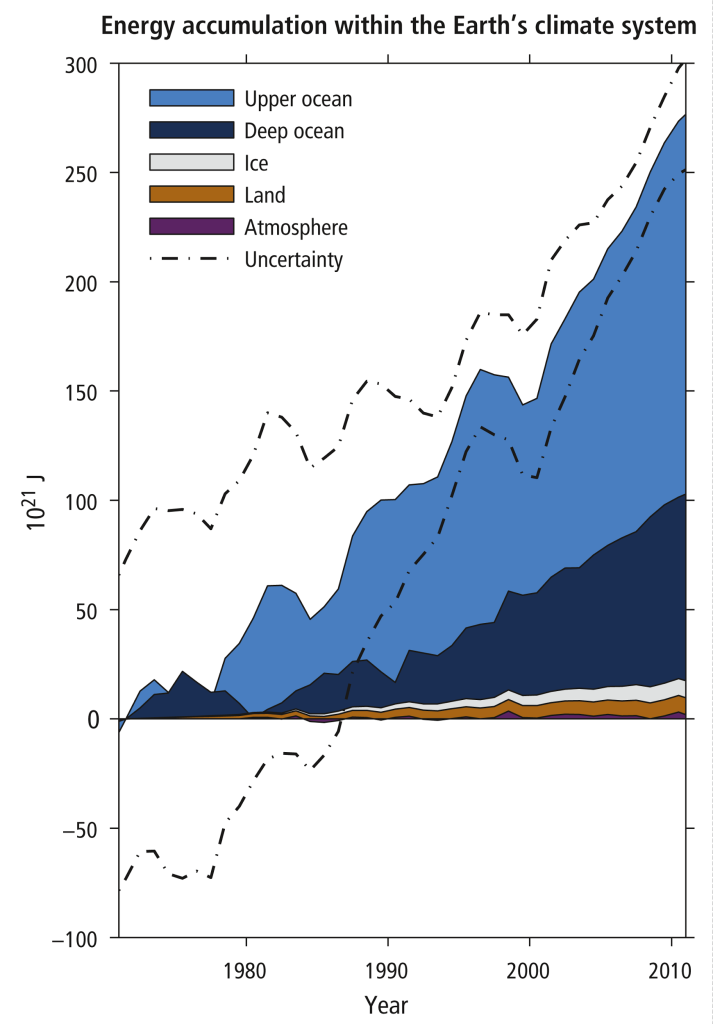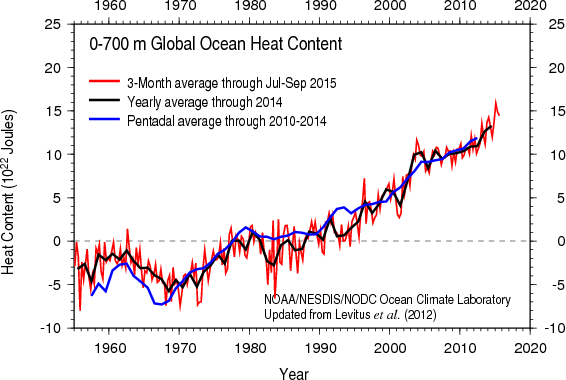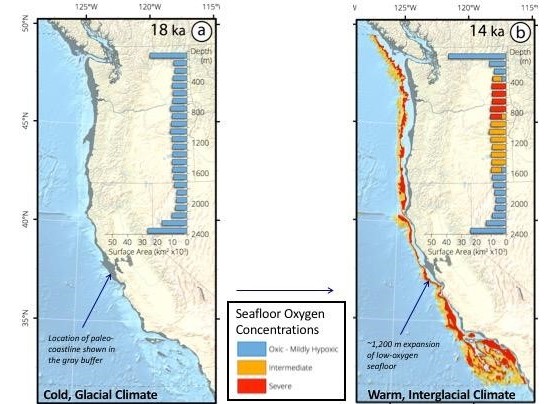In earlier posts, my colleagues Joseph Majkut and Thomas Cropper explained why Michaels and Knappenberger are mistaken to conclude that the climate is not as sensitive to greenhouse gas emissions as generally believed and why their indictment against the climate models is greatly overstated. One of the most glaring problems with the Michaels and Knappenberger analysis, however, is that—like most climate skeptics—they omit a huge part of the global heat budget: the ocean. Focusing on a single number like climate sensitivity leaves out a huge part of the climate change that we are observing.
How fast the ocean takes up excess heat from the atmosphere and how that excess heat will eventually be distributed is an important aspect of the global climate system. That’s because, as Figure 1 demonstrates, the excess heat trapped by human greenhouse gas emissions is primarily stored in the ocean.
Figure 1: Ocean heat accumulation over the last half century dwarfs that of the atmosphere. Source: IPCC 2015 Summary Report, Figure 1.2
This oceanic heating, which is monitored regularly, is critical to the heat budget of the climate. And as Figure 2 demonstrates, there has been absolutely no pause over the past couple of decades in the warming found in the upper 700 meters of the ocean. If we are looking for a warming signal, we find it unambiguously here. Ultimately, we cannot simply look at surface or atmospheric warming trends over relative short periods of time and extrapolate forward. We have to consider trends in the heat budget of the oceans and what that portends for future atmospheric warming.
Figure 2: Heat content of the upper ocean from measurements by oceanographic instruments.
For my part, I have studied the oceanographic and biological consequences of abrupt climate warming in the very recent glacial and interglacial climates of the Late Pleistocene (from 20,000 years ago to the present). Unlike modern human made climate warming, the principal driver of warming at that time was the change in Earth’s orbit around the sun. And that event of climate change led to ocean surface warming, sea level rise, and increases in atmospheric carbon dioxide concentrations as changing ocean circulation delivered gases to the atmosphere.
There are a number of dangerous ecological consequences from oceanic warming beyond its impact on surface and atmospheric temperatures. Consider the extensive loss of dissolved oxygen in the ocean interior that follows from warming (e.g. Rabalais et al. 2008 and Moffitt et al. 2015, here is a factsheet). Figure 3, for instance, shows the loss of oxygen off of the coast of California that occurred between a cold and warm climate.
Figure 3: Environmental reconstructions of sea floor oxygen loss through an event of global-scale climate warming. Both panels are reconstructions of oxygen concentrations in the California Margin during a cold, glacial climate (left, 18,000 years ago) and a warm, interglacial climate (right, 14,000 years ago; Moffitt et al. 2015a).
Climate shifts also co-occur with major changes in the distribution of marine ecosystems, and these shifts can occur on the timescales of decades to centuries (Moffitt et al. 2015b, here is a factsheet). While major oceanographic and ecological disruption due to abrupt climate warming occurs on the timescale of a human life (from decades to centuries), recovery from abrupt warming disturbances can take hundreds to thousands of years.
Ocean warming is occurring in concert with the acidification of ocean waters (e.g. Doney et al. 2009), as well as changes in ocean circulation (e.g. Bakun et al. 2009). All of these changes are a product of human-made climate change and all impose significant risks to human civilization.
Climate Sensitivity in Context
It is important to keep in mind that climate change disrupts Earth systems that, through human history, were essentially stable. However, across the fields of climate modeling, instrumental observations, and paleoclimate reconstructions, the scientific community is demonstrating that these systems are not stable.
In fact, many of the physical, chemical and biological planetary systems have the capacity to respond very quickly and catastrophically when the heat budget of the planet is altered. Even if climate sensitivity is on the lower end of the existing range in estimates, climate warming will come with planetary-scale reorganizations in the distributions of ecosystems. Such large biological shifts—on the scale of previous geological events—illustrate the scale of risk and consequences associated with human-caused climate change.
Ultimately, the question focused upon by Michaels and Knappenberger is a narrow slice of an incredibly large field of science surrounding climate change. To truly understand the nature of the changes that are occurring and where those changes will take us, it is imperative to look at all of this evidence.
[Photo credit: NASA Goddard Space Center via Wikimedia Commons]


